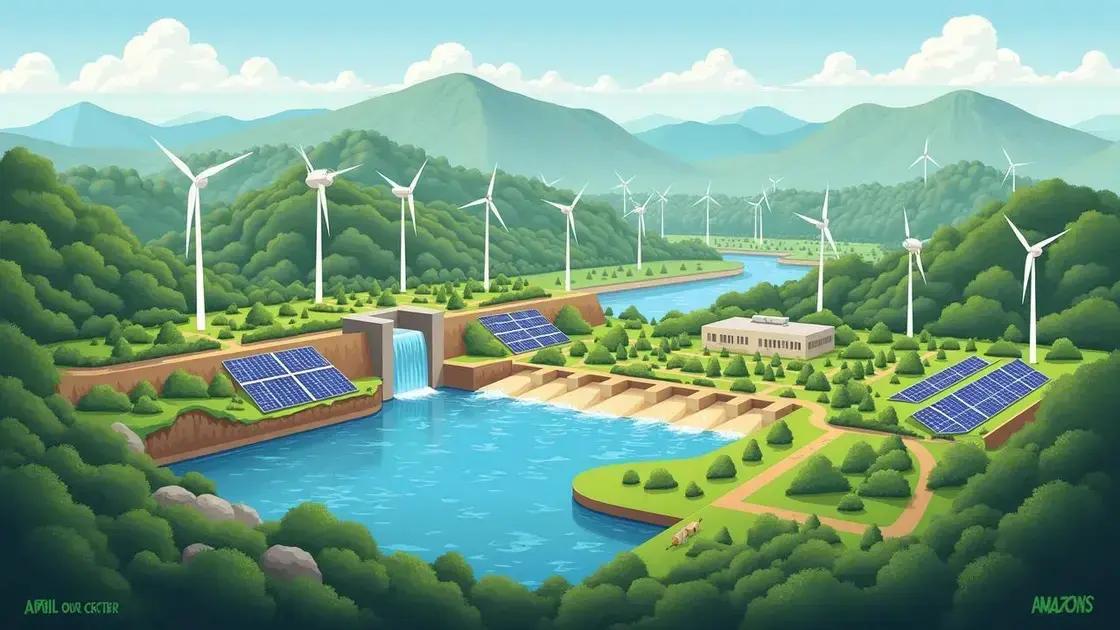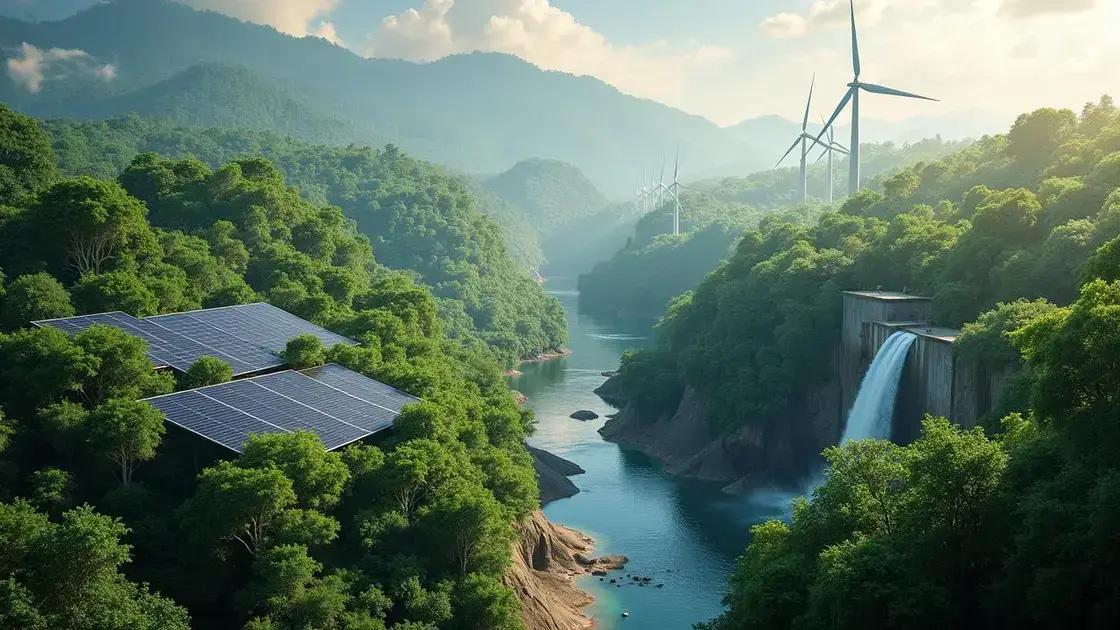Amazonic Power refers to the sustainable energy derived from the Amazon rainforest, utilizing resources like hydropower, solar energy, and biomass. This energy source offers significant benefits for reducing carbon emissions while supporting local communities, biodiversity, and ecological health. The future of Amazonic Power looks promising with emerging technologies and community involvement driving sustainable practices.
The composition of Amazonic Power is essential for understanding the energy dynamics within the Amazon rainforest. By exploring the various elements that make up this powerful source, we can appreciate its significance for both local and global ecosystems. This article delves into the definition of Amazonic Power, its key components, the environmental impact associated with its utilization, and what the future holds for this unique energy source.
Defining Amazonic Power

Amazonic Power refers to the energy generated from the natural resources found in the Amazon rainforest. This energy source is unique due to the rich biodiversity and varied ecosystems that exist in this region. It plays a crucial role in supporting the local communities and contributes to a larger environmental balance.
In essence, Amazonic Power encompasses everything from hydropower generated by the rivers to solar energy harnessed from the sun. The rainforest’s vibrant ecosystems offer numerous opportunities for harnessing energy while maintaining ecological integrity.
Understanding the Role of Biodiversity
The Amazon rainforest is home to thousands of species of plants and animals, influencing the types of energy resources available. Plants, through photosynthesis, store solar energy that can be converted into biofuels. Additionally, the rich water systems support sustainable hydropower projects, harnessing the power of flowing rivers.
Sustainable Practices
Defining Amazonic Power also involves looking at how energy is sourced sustainably. Sustainable practices help to protect the environment and preserve the unique ecosystems of the Amazon. These practices include reforestation, responsible hydroelectric projects, and the promotion of renewable energy technology.
Community Involvement
A significant aspect of Amazonic Power is the involvement of local communities in energy production. Many indigenous communities contribute traditional knowledge to develop sustainable energy solutions that benefit both the environment and their way of life. This integration of local insights ensures that energy solutions are culturally appropriate and environmentally sound.
Key Components of Amazonic Power

The key components of Amazonic Power are vital for understanding how energy is generated and utilized in the Amazon rainforest. These components include renewable resources like water, sunlight, and biomass that enable the production of sustainable energy.
Hydropower
Hydropower is one of the primary components of Amazonic Power. Rivers in the Amazon create a robust infrastructure for generating electricity. By capturing the kinetic energy of flowing water, hydropower plants can produce a significant amount of energy while also supporting local ecosystems.
Solar Energy
Another crucial component is solar energy. The Amazon region receives abundant sunlight, which can be harnessed using solar panels. This clean energy source supports electricity generation in remote areas, reducing dependence on fossil fuels and helping promote sustainable living.
Biomass
Biomass, derived from organic materials like plants and agricultural waste, is also a key player in Amazonic Power. By converting biomass into energy, communities can create renewable energy sources while managing waste effectively. This practice not only generates power but also supports local economies.
Wind Energy
Wind energy is an emerging component in certain areas of the Amazon. Although not as prevalent as hydropower or solar energy, advancements in technology are making it possible to harness wind resources. Wind turbines can complement existing energy systems, helping to diversify the energy mix.
Environmental Impact of Amazonic Power

The environmental impact of Amazonic Power is significant in both positive and negative ways. As renewable energy sources increase in the Amazon, it’s essential to assess how they affect local ecosystems and communities.
Positive Effects
One of the main positive impacts is the reduction in carbon emissions. By utilizing hydropower, solar energy, and biomass, the reliance on fossil fuels decreases. This shift helps to combat climate change and preserve air quality.
Sustaining Biodiversity
Amazonic Power can also play a role in sustaining biodiversity. Sustainable energy practices, such as responsible hydropower and biomass production, help to protect plant and animal habitats. When managed properly, these energy sources can maintain the delicate balance of the rainforest’s ecosystems.
Potential Negative Consequences
However, there are potential negative consequences as well. Large-scale hydropower projects can disrupt river ecosystems and fish populations. Deforestation, even for biomass, can lead to loss of habitats and species, undermining biodiversity goals.
Community and Cultural Impact
Local communities may experience changes due to shifts in energy use. While some benefit from new energy sources, others might be negatively affected by development projects that displace them or alter their lifestyle. It is crucial to ensure that energy development aligns with the needs and rights of indigenous peoples living in the Amazon.
Future of Amazonic Power

The future of Amazonic Power holds great promise as the world shifts toward cleaner energy solutions. As technology advances, there will be more opportunities to harness the untapped resources in the Amazon rainforest.
Emerging Technologies
Innovative technologies are likely to play a major role in the development of Amazonic Power. New hydropower techniques, improved solar panels, and biogas systems are being researched. These technologies will help reduce the environmental footprint while maximizing energy output.
Community Involvement and Education
Involving local communities in future energy projects is essential. As awareness increases about the benefits of sustainable energy, more residents will understand their roles in protecting the environment. Educational initiatives can empower individuals to participate in the energy transition.
International Collaboration
Global partnerships might also shape the future of Amazonic Power. Collaboration between governments, NGOs, and private sectors can lead to sustainable financing and resource management. Working together, these groups can create policies that prioritize ecological health and energy access.
Conservation and Restoration Efforts
The future will require balancing energy needs with conservation efforts. Investing in restoration projects and sustainable practices will be crucial to maintaining the Amazon’s rich biodiversity. By protecting ecosystems, we can ensure that the energy generated does not compromise the forest’s integrity.
In conclusion, understanding Amazonic Power is essential for a sustainable future
The composition and key components of Amazonic Power showcase the potential of the Amazon rainforest as a significant energy source. By utilizing renewable energy such as hydropower, solar, and biomass, we can reduce our reliance on fossil fuels.
While there are both positive and negative environmental impacts, a balanced approach toward sustainable energy can help protect the unique ecosystems of the Amazon. The future of Amazonic Power looks promising, with emerging technologies and community involvement paving the way for more responsible energy production.
As we continue to explore and develop Amazonic Power, it’s crucial that we prioritize conservation and restoration efforts to ensure the health of the rainforest for generations to come. By doing so, we not only support local communities but also contribute to the fight against climate change.
FAQ – Frequently Asked Questions about Amazonic Power
What is Amazonic Power?
Amazonic Power refers to the energy derived from renewable resources found in the Amazon rainforest, including hydropower, solar energy, and biomass.
What are the key components of Amazonic Power?
The key components include hydropower, solar energy, biomass, and emerging technologies like wind energy, all contributing to sustainable energy production.
How does Amazonic Power impact the environment?
Amazonic Power has both positive and negative environmental impacts, including reduced carbon emissions and potential disruption of ecosystems from large-scale projects.
What is the future outlook for Amazonic Power?
The future of Amazonic Power is bright, with emerging technologies, community involvement, and international collaboration enhancing sustainable energy practices.
How can local communities benefit from Amazonic Power?
Local communities can benefit through job creation in renewable energy sectors, involvement in energy projects, and access to more sustainable energy solutions.
What role does biodiversity play in Amazonic Power?
Biodiversity is crucial for sustaining the ecosystems that support renewable energy sources; maintaining healthy ecosystems helps ensure the viability of these energy options.












